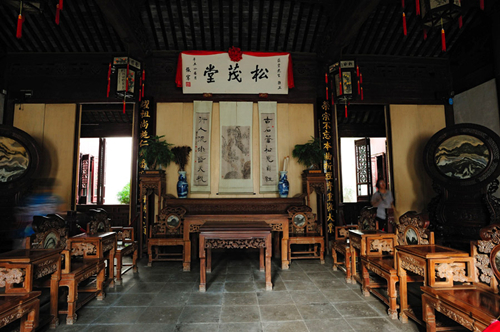Zhouzhuang: China's first water-town
(chinadaily.com.cn)
Two houses

Shen's House
Shen's House was built by Shen Benren, descendant of Shen Wansan, in 1742 (the seventh year of Emperor Qianlong in the Qing Dynasty (1644-1911)). Facing west, it covers an area of over 2,900 square meters, with seven rows (or jin in Chinese, which means any of the several rows of houses within an old-style residential compound) and five gateways, totaling over 100 rooms.
The first row is a gate next to a watercourse, equal to a private wharf, where hosts greeted distant relatives who came by boat.
The second row is a hallway decorated with lanterns and streamers. A red lantern hung in the hallway indicates a happy event in the Shen family. On the top of the hallway is carved a golden cornucopia, standing for treasure.
In the courtyard you can see a stone tablet carved with three Chinese characters jing ye tang ("dedication hall"). According to records, Shen Benren, the owner of the house, ignored his proper occupation in his early years. After his father died, he was criticized by others that he would dissipate his family fortune within three years if he kept up such bad behavior. After deep consideration, he decided to live in complete seclusion to manage farmland with his whole heart. Later, he expanded Jingye Hall, which is today's Shen's House, and cultivated acres of farmland. The Shen family developed into a rich and influential family gradually through years of effort.
The third row is a tea room. Influenced by the hierarchy of feudal society, distinguished guests were entertained in the main hall, while boatmen and bearers waited for orders in the tea room.
The gateway between the third and fourth row is the most elaborate in the house, with four Chinese characters ji hou liu guang engraved in the middle. It is a Shen family instruction that means accumulating merits and carrying forward this fine tradition. The tile carving is in the Hui style, one of the major Chinese architectural styles of ancient times, with exquisite homes, ancestral halls and memorial archways as its most impressive embodiments. In addition, Shen’s House has a variety of horse head walls, or matou walls, which play a decorative role, reduce wind velocity and slows the spreading of fire. Therefore, the walls are also called fire seals.
The fourth row is the main hall to receive guests and worship ancestors. As the center of the house, it is very large and impressive. The main hall is named Songmao Hall, indicating that money and treasures will be plentiful. There's a three-claw dragon carved in the hall, which is a symbol of wealth. The hall has two layers of roofs, of which only the lower layer can be seen. This structure can stay cool in summers and warm in winters. The house’s furniture is relatively large and elegant with fine carvings, which is a significant feature of the Qing-style furniture. In addition, a floor screen is inlaid with natural marble.
The fifth row is where women live, equipped with small and delicate furniture. There is a ta, like a bed, equivalent to a couch, on which women had tea, played chess and chatted.
The sixth row is a small hall with a statue of Shen Wansan. After moving from Nanxun, Zhejiang province, to Zhouzhuang, Jiangsu province, the family started off farming and accumulated a certain amount of money. Later, Shen Wansan shipped out silk and porcelain to Southeast Asia and shipped in foreign jewelry to sell, taking full advantage of Zhouzhuang’s water conservancy conditions.
The seventh row is a dining hall. The most famous dish of Shen's family feast is Wansan pork shank, which is a symbol of reunions now.
A kitchen is beside the dining hall. It is equipped with four big caldrons and two small pots. A black movable board in front of the kitchen range is equal to an apron. Two holes above the kitchen range are equal to range hoods, and a red stool is a juicer.
Shen's house suffered great damage during the Cultural Revolution (1966–76). After restoration, it regained its original appearance and became a favorite attraction.
KUNSHAN IN MY EYE
- A novel venue to celebrate the art of Kunqu
Kunqu artist Zhang Jun racked up a new career achievement during his performance at the Modern Drama Valley festival at the Mercedes-Benz Arena on May 18, performing in a venue that is several times larger than what he is used to.
- US travel companies discover Suzhou
39 American travel professionals were given a two-day tour of the 2,500-year-old city from Sept 13 to 14, including visits to famous sights like Tiger Hill and Shantang Street, as well as chances to experience traditional Chinese art.


